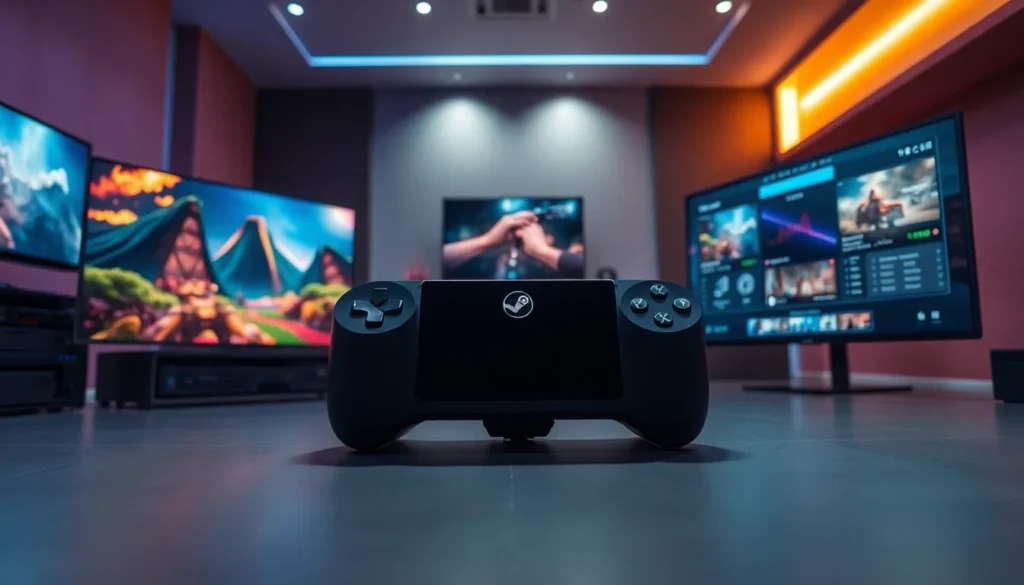Table of Contents
ToggleGaming on the go is what the Steam Deck promises, but the choice between LCD and OLED can feel like standing at a buffet where every dish looks tempting and terrifying in equal measure. It’s like deciding whether to ride a rollercoaster or a merry-go-round, each has its thrills, but the experience differs vastly. So, is it time to go vibrant with OLED, or should you stick to the tried-and-true reliability of LCD? Buckle up as we jump into the dazzling world of display technologies to uncover what you really need for your gaming escapade.
Understanding Display Technologies

What Is LCD Technology?
Liquid Crystal Display (LCD) technology uses liquid crystals sandwiched between glass layers. When an electric current passes through, these crystals align to allow light through, creating images. LCDs have been the workhorse of monitors and TVs for years and are known for their cost-effectiveness and brightness in well-lit conditions. But, they don’t deliver deep blacks because of how backlighting works.
What Is OLED Technology?
Organic Light Emitting Diode (OLED) technology, on the other hand, uses organic compounds that emit light when electricity is applied. Each pixel lights up independently, which allows for incredible contrast ratios and stunning color reproduction. Imagine watching a horror game with pitch-black shadows popping against luminous graphics, chilling, right? But, with great power comes the need for caution: OLEDs can be susceptible to burn-in, where static images can damage the display over time.
Key Differences Between LCD and OLED
Color Accuracy and Vividness
When it comes to color, OLED takes the cake. The ability of OLED displays to produce true blacks means colors appear more saturated and vibrant. This translates to more immersive gameplay, where subtle color differences can mean the difference between victory and defeat. LCDs can struggle here, especially in low-light scenarios.
Contrast Ratios and Black Levels
If contrast is king, OLED is the undisputed monarch. With its ability to turn off individual pixels, OLED can achieve infinite contrast with vibrant highlights against inky blacks. Conversely, LCDs rely on backlighting, which can sometimes leak into dark scenes, muddying the viewing experience.
Response Time and Refresh Rates
In fast-paced gaming, response time can significantly impact performance. OLED displays typically boast quicker response times, reducing motion blur during hectic scenes. That’s great news for action lovers. While many LCDs have improved significantly, they often can’t match the speed of OLED.
Power Consumption and Efficiency
Now, let’s talk stamina. When it comes to power efficiency, LCDs usually win out, especially when displaying brighter images. OLEDs tend to consume more power when showing lighter scenes due to their nature of lighting up each pixel. If long gaming sessions are on the menu, this might be a crucial consideration.
User Experience on the Steam Deck
Performance in Games
Both LCD and OLED displays shine in specific gaming scenarios. FPS games, rich with dark environments, showcase OLED’s impressive blacks and color vibrancy. Conversely, if gaming under sunlight, outdoors or even near a window, LCDs with their higher brightness levels can outperform OLEDs, where sunlight might wash out colors.
Screen Glare and Outdoor Use
Screen glare can be an absolute game-changer when playing on the go. OLEDs, while stunning indoors, may struggle against bright light. A reflective surface adds distractions, making it harder to game effectively outside. In contrast, LCDs, though not immune to glare, can be more manageable in bright sunlight, allowing for more flexible gaming situations.
Price and Availability
Cost Implications of Each Display Type
Price can play a significant role in decision-making. LCD screens tend to be more budget-friendly, making them the go-to choice for many consumers and manufacturers. OLEDs, while offering superior quality, often come with a hefty markup. It’s essential to weigh the benefits against the cost, especially for casual gamers who might not notice the subtle differences.
Future-Proofing Your Choice
Looking ahead, OLED technology is gaining traction in various devices. As gamers increasingly demand higher-quality visuals, investing in an OLED screen could be seen as future-proofing your gaming experience. But, considering the current market landscape, a solid high-quality LCD might still serve well for years to come.







